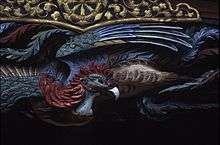Taiseki-ji
| Taiseki-ji Sohonzan (Temple complex) 大石寺 | |
|---|---|
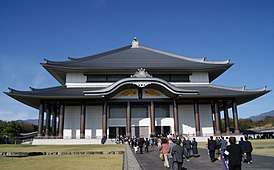 The Hoando Main Temple | |
| Basic information | |
| Location | Fujinomiya-shi, Shizuoka prefecture, Mount Fuji |
| Affiliation | Nichiren Shōshū |
| Deity |
Nichiren Daishonin as the Dai-Gohonzon of the High Sanctuary of the Essential Teachings |
| Country | Japan |
| Status | Active |
| Website | http://www.nichirenshoshu.or.jp/ |
| Architectural description | |
| Founder | Nikkō Shonin |
| Completed | 1290 |
| Taiseki-ji | |||||
|
"Taiseki—ji" in kanji | |||||
| Japanese name | |||||
|---|---|---|---|---|---|
| Kanji | 大石寺 | ||||
| |||||
The Taiseki-ji High Sanctuary of the Essential Teachings (大石寺 (多宝富士大日蓮華山大石寺) Tahō Fuji Dainichirenge-zan Taiseki-ji), informally known as Taiseki-ji Head Temple sōhonzan (総本山) (English: "Great Rock Field") of the Nichiren Shōshū. It is located on the lower slopes of Mount Fuji in Kamijo, Fujinomiya, Shizuoka Prefecture, Japan.
Taiseki-ji was a land donated by Nanjo Shichiro-Jiro Tokimitsu, later founded in the year 1290 by Nikkō Shōnin, one of Nichiren's immediate disciples, and is known for being the home of the venerated Dai-Gohonzon within the Hoando temple complex. The vicinity is visited annually by faithful believers who go on Tozan religious pilgrimages. For the most part, Taisekiji's roaming grounds are open to tourists and visitors for sightseeing, while most buildings, such as the Hoando, are solely restricted only to vowed temple Hokkeko members and pilgrim believers.
Taiseki-ji today

Nichiren Shōshū's head temple is the administrative center, and its chief abbot (貫主 Kanzu So) (English: Chief Abbot Priest) is simultaneously the high priest (法主 Hossu) of Nichiren Shōshū. The current High Priest is Nichinyo Hayase (b. 1935), who assumed the position on 16 December 2005. Hayase is the 68th in a lineage that Nichiren Shōshū traces back to Nichiren (1222–1282). He is formally styled as 68th High Priest Nichinyo Shōnin in English.
As it is the head temple of Nichiren Shōshū and therefore home of the Dai Gohonzon (Nichiren Shōshū's ultimate object of veneration), Taiseki-ji is visited by believers from around the world. They come on personal pilgrimages, to participate in regular ceremonies, or to take part in large events such as temple-group pilgrimages, workshop-style study programs, and large rally-like meetings. The temple is visited by several hundred thousand pilgrims annually, and its compound is known for several historically significant buildings and gardens, as well as old weeping cherry trees that line its tatchū (main path lined with lodging temples).
History
Founding and early period
According to Nichiren Shōshū tradition, Taiseki-ji was founded in 1290 by Nichiren's disciple Nikkō on a tract of land called "Ōishi-Ga-Hara (大石ケ原)" (English: Big Stone Field) donated by the district steward, Nanjō Shichiro-Jiro Tokimitsu (1259–1332). The archaic name derives from an alternate reading of the kanji for Ōishi (大石), taiseki, and ji (寺), which means temple. Tokimitsu was one of Nichiren's lay followers and he looked up to Nikkō as his personal teacher. It started with one small temple building but grew gradually as Nikkō's disciples built sub-temples. It went through further growth phases during the mid-Edo period and in the post-World War II period.
Buildings
The significant buildings are listed for its historical value and main attraction. Several buildings not described herein are considered minor, demolished in construction.
San-mon Gate
.jpg)
The Sanmon (written 三門, sometimes 山門) gate is Taiseki-ji's "front door" and has been designated as a Shizuoka prefectural cultural asset. It was built in 1717 with monetary assistance from Lady Tennei-in, the wife of sixth Shogun Tokugawa Ienobu, who donated 300 Ryō gold pieces ($360,000 USD) for its construction. It is the closest Taiseki-ji monument in proximity to public government roads. In 1997, it suffered significant vandalism and graffiti tagging. It is currently tented under enlargement and reconstruction with a deadline of January 2021.
Mutsu-bo

The first Mutsubo (六壷) was erected in 1290, making this historically Taiseki-ji's first building. It has been rebuilt many times since. Inside the temple is a gohonzon claimed to be from Nikko Shonin.[1] The current structure, which uses much keyaki heartwood, was completed in 1988. The Mutsu-bo building is the second location in which the High Priest of Nichiren Shoshu transfers to once Ushitora-Gongyo is concluded, where in this building, another morning Gongyo recitation is offered by the young priests acolytes who are in training.
Toba-Shitsu
The Toba-Shitsu office is a specialized building next to the Mutsubo where Toba memorial tablets and stupa are offered by Hokkeko members for their deceased friends, relatives and pets. The memorial tablets are inscribed by a groups of young priests assigned in the building, while a designated second floor is where the memorial tablets are stored for veneration. The donations collected for the memorial tablets are allocated for the maintenance of the Taiseki-ji gardens. In this building, only Japanese Yen currency is accepted for donations and Hokkeko members may be assisted by the younger priests to begin the procedure for one's deceased ashes to be enshrined in the columbarium of the head temple.
Dai-Kya-kuden
The Kyakuden (客殿: Reception Hall) was first built in 1465. The current structure, a wood-clad steel-framed structure, was completed in 1998 and replaced the a previous steel-reinforced concrete building from 1964. The previous structure was built and donated by the lay believers of Nichiren Shoshu and was replaced because of worries about structural integrity in a major earthquake. The priesthood also cited its imposing ferroconcrete mass as incongruent with the architectural tone appropriate for a temple compound. A pre-war building, which had been requisitioned by the Japanese imperial military, burnt down in a June 1945 arson that claimed the life of 62nd High Priest Nikkyō Shonin.
The Reception Hall is the site of ushitora Gongyō, a prayer service performed daily at the transition from the "hour of the ox (ushi)" to the "hour of the tiger (tora)". The service begins at about 2:30 AM and ends about an hour later. This is believed to mark the transition from darkness to light as well as the hour at which all Buddhas attain enlightenment. The service is customarily officiated by the high priest or his proxy. The purpose of the service is, among other things, to pray for the spread of the teachings of Nichiren Daishonin throughout the world and thereby bring about peace and prosperity for all humankind. The Ozagawari Gohonzon (English: Gohonzon of the High Seat of the Buddhist Law) is prominently enshrined within the Dai Kyakuden on its second floor, flanked by two lifesize statues of both Nichiren Daishonin (LEFT) and Nikko Shonin (RIGHT).
Mieidō
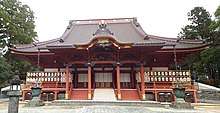
The original Mieidō (御影堂: image hall) was built in 1522. The Mieidō houses an image of Nichiren Daishōnin (hence its name) with the earliest historical records dating from 1388. The current, classical structure was built in 1632 and has had several subsequent renovations, the most recent major one in 1971. It was designated a cultural asset by Shizuoka Prefecture in 1971. After a major renovation that took ten years, the Mieido was reopened in November 2013.
For the renovation, the whole structure was taken apart piece by piece, damaged parts were repaired, and finally rebuilt into its original state. But, underneath the antique structure, and invisible to the eye, a modern, earthquake resistant system is integrated using metal springs installed underground. The Mieido hall has pillars of gold leaf, arabesque altar fittings and a supreme vermilion interior portraying various Buddhist gods on the upper transoms who are believed to occupy the Treasure Tower of the Lotus Sutra. Inside the inner sanctum of the building is the venerated Namamiei statue of Nichiren Daishonin, created during the subject's lifetime, per oral tradition.
Hōandō
The Hōandō (奉安堂: hōan is an honorific form of a verb meaning to enshrine or place in an altar; dō is a large building or hall) houses the Dai Gohonzon, the supreme object of worship and veneration in Nichiren Shōshū.
The Hōandō is a temporary storage house built in the style of a traditional Japanese storehouse to signify that kosen-rufu (広宣流布) has yet to be achieved. Loosely defined, kōsen rufu means that the Nichiren Shōshū faith has taken hold as the primary religion of the world's people. This is significant to the Nichiren Shōshū faithful because they believe that, according to Nichiren's will, the Dai Gohonzon is not to be made publicly accessible, but rather stored away and only viewed by those who have asked for and been granted an audience by the high priest, until kōsen rufu has been achieved. A further symbol of this is that, different from all other Nichiren Shōshū altars, the one in the Hōandō is neither decorated with an offering of evergreens nor drums, rendering its altar as incomplete and non-believers are not permitted within while handicapped members and their guardian receive preferential entrance and seating to the building.
At the Shumidan high altar of the Hoando is the Stupa containing the ashes of Nichiren Daishonin (Left), Dai-Gohonzon (Center), and a statue of Nichiren Daishonin carved by Izumi Ajari Nippo Shonin from the same camphorwood of the Dai Gohonzon upon which Nichiren Daishonin once commented of having similar facial features. The Butsudan area itself is referred to as Shumisen.
The Hōandō replaced the Shōhondō (正本堂: true main hall), the Dai Gohonzon's previous home. Before the Shōhondō was completed in 1972, the Dai Gohonzon had been kept locked away in a storehouse called the Treasure House (御宝蔵: Gohōzō) or enshrined in the Hōanden (奉安殿), another storehouse-like structure built behind the Treasure House.[2]
Gohozo / Hoanden
The treasure house (Gohozo) is only open to believers. Inside there are scrolls and paintings of importance to this sect of Nichiren Buddhism, as well as information about the religion and its history. It also features modest displays of cultural objects donated by pilgrims from countries where they have attracted converts. In the back is the Hoanden building.
The five story Pagoda
_of_Taiseki-ji.jpg)
Completed in 1749 with the assistance of the Edo government, Taiseki-ji's pagoda costed 5000 gold Ryō (modern equivalent $6.5 million USD). The pagoda (Japanese: Tō) faces west rather than the usual south to signify that Nichiren Buddhism would spread from the east (Japan) to the west (back to the land of Sakyamuni Buddha and beyond). It is the largest five-storied pagoda along the Tōkaidō, the historical main highway along Japan's eastern seaboard from Edo (today's Tokyo) to Kyoto. The structure was designated a national cultural treasure in 1966. It is opened every February 16 for ceremonies to celebrate Nichiren's birthday. Its artistic reconstruction has concluded and opened in January 2017. On the left side of this pagoda is the tombstone of the famed Soka Gakkai leader, Josei Toda, whose remains were re-enshrined in 2001 from the Jozai-ji Temple of Toshima, Tokyo.
Notable buildings nearby
Myoren-ji Temple
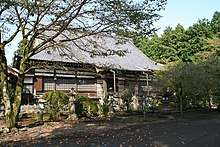
An approximate 30-minute walk from the Head Temple is the famed Myoren-ji temple, which is the former residence of Nanjo Tokimitsu, whom donated the land of Taisekiji to Nikko Shonin. The temple is named after his wife's Buddhist Kaim-yo name, Myo-Ren. Inside this temple are many artifacts, in particular an original Gohonzon enshrined at its main altar, which was inscribed by Nichiren Daishonin himself, and a decorative small statue of him preserved as a historical remembrance. The priest assigned to this temple is the son of Reverend Urushibata, head of Overseas Nichiren Shoshu bureau and is known for celebrating its own Oeshiki ceremony.
Extinct buildings
Shōhondō

In 1968, approximately 8,000,000 Soka Gakkai adherents contributed money to construct the building which was to be [3] the Shōhondō building at Taiseki-ji, opened from 1972 and completely demolished in 1998. The Soka Gakkai inaugurated the building as the High Sanctuary of the Dai Gohonzon as mandated by Nichiren Daishonin, a title that was disputed by the Myoshinko lay organisation at the time. The temple priesthood, along with Nittatsu Hosoi also directed that the Sho-Hondo as a temporal shrine for the venerated image, issuing a Gohonzon to Daisaku Ikeda with a hand inscription commemorating its construction but refraining from assigning it to be its permanent home. As Nittatsu Shonin wrote in 1973:[4]
The Sho-Hondo is the True High Sanctuary at the present time, and carries the significance stated in the Transfer Document, "Document for Entrusting the Law that Nichiren Propagated Throughout his Life" ("Nichiren ichigo guho fuzoku-sho") and [the Gosho] "On the Three Great Secret Laws." – (Collected Words of High Priest Nittatsu Shonin, vol. 2-1, p. 3)
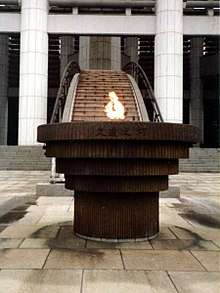
The design of the Shohondo itself is alluded to a crane bird taking its flight, similar to the official logo of the Nichiren Shoshu school while its entrance gates are alluded to the lotus flowers. Outside of the entrance itself was a pond where believers could purify their hands in traditional Japanese manner. Inside featured mid-century modern architecture, bronze carvings and an automatic door Butsudan, considered to be a rare novelty at the time. In its high altar is the main shrine was built to house the Dai-Gohonzon, an inscribed wood block mandala which is the "True Object of Worship" of Nichiren Shōshū.
The Shōhondō was regarded as an important work of post-war Japanese architecture, noted for its vast unsupported roof span. The construction of the Shōhondō was funded largely by the personal donations of the lay believers of the Nichiren Shōshū. An estimated ¥35,536,000,000 was raised, of which ¥35,064,300,000 came from Sōka Gakkai adherents, ¥313,820,000 from Hokkekō adherents and ¥157,870,000 from priests and their families.[5]
The official reason cited by Nichiren Shōshū for demolishing the building is due to the metal rust discovered on the pillars within the temple. Official reports were conducted by engineers who researched and validated the same ocean sand used for the mortar construction of the building, possibly risking the Dai Gohonzon's safety during an seismic earthquake. The report took one full year to complete and its results were submitted to High Priest Nikken for review. The school also concedes that its demolition of the Shōhondō was an extension of the doctrinal dispute between it and the Sōka Gakkai, emphasizing the impurity of the organisation for deviating from its formal doctrines of orthodoxy.[6] Former Nichiren Shōshū High Priest, Nikken Shōnin replaced the Shōhondō with the traditional style building of Hōandō in 1998.
The Soka Gakkai refutes both the report and the reason for its demolition. Non-Japanese architects, such as Richard Meier and Robert A M Stern. Terence Riley, former chief curator of architecture and design at the Museum of Modern Art in New York, said that the planned demolition would be a "regrettable finale" to a century that has "witnessed so much loss.".[7] The buildings of Hoando, Mieido, Dai-Kyakuden and Gohozo have all been completely rebuilt.
Dai Kodo

The last Soka Gakkai building now in the Head Temple is the Dai-Kodo (English: Great Lecture Hall) built in 1 March 1958 and is timely scheduled to be destroyed and rebuilt as a traditional building. The condition of the building since is poorly unrestored and dilapidated. Located within this building is the Gohonzon of Nichiren Daishonin endowed for the enlightenment of women, given to Sennichi, the pious wife of disciple Abutsubo. Flanked in this altar are the two ihai memorial tablets of second High Priest, Nikko Shonin and third successor, Nichimoku Shonin. It is scheduled for demolition and reconstruction after the completion of the new Sanmon gate in 2021.
Sources and references
- Nichiren Shōshū nyūmon (日蓮正宗入門: Introduction to Nichiren Shoshu), Taiseki-ji, 2002
Notes
- ↑ http://blog.livedoor.jp/saikakudoppo/archives/50865483.html
- ↑ Shōhondō was largely built at the behest of Soka Gakkai, but the Nichiren Shōshū priesthood stripped Soka Gakkai of its status as a lay organization in 1991 and later determined that a structure built by an organization that had turned heretical was no longer suited to house the Dai Gohonzon. In the priesthood's eyes, Soka Gakkai had proved through its actions that its motivation for building the Shōhondō was impure, so Nichiren Shōshū had the Shōhondō torn down. In this context, Nichiren Shōshū freely concedes that its demolition of the Shōhondō was an extension of the doctrinal dispute between it and Soka Gakkai (Sōka Gakkai-in e no shakubuku kyōhon [Text for refuting Soka Gakkai's misrepresentations to its members], Takisekiji, 2004. p. 330–331). There had been friction over the naming of the building from around the time construction began because many Nichiren Shōshū priests felt that, given that kōsen rufu had not yet been achieved, it was too early to erect Taiseki-ji's "True Main Hall" (Ibid, p. 74–75). Taiseki-ji has traditionally regarded the Mieidō (see above) as the temple's hondō (main hall), but only its provisional main hall until kōsen rufu is achieved, when the building housing the Dai-Gohonzon would take over that role. Note that almost all temples, regardless of school, have one building or section of a building considered their hondō, which is usually where their most significant ceremonies are held.
- ↑ Ikeda, Kiyoaki Murata ; foreword by Daisaku (1969). Japan's new Buddhism : an objective account of Soka Gakkai ([1st ed.]. ed.). New York: Weatherhill. p. 135. ISBN 978-0834800403.
- ↑ https://www.nst.org/sgi-faqs/the-history-of-the-relationship-between-nichiren-shoshu-and-the-soka-gakkai/2-daisaku-ikeda-becomes-third-president-of-soka-gakkai/
- ↑ Corrigendum in Dai-Nichiren, July 1991. Published by Nichiren Shōshū.
- ↑ Sōka Gakkai-in e no shakubuku kyōhon (Text for refuting Soka Gakkai's misrepresentations to its adherents), Taisekiji, 2004. pp. 330– 331.
- ↑ "A Major Eruption At the Foot of Fuji". members.aol.com. Washington Post. June 14, 1998. Archived from the original on 1999-11-03. This article is also referenced in Jane Hurst, "A Buddhist Reformation", in Global Citizens: The Soka Gakkai Buddhist Movement in the World eds. David W. Machacek, Bryan R. Wilson, Oxford University Press, 2001, p.70
| Wikimedia Commons has media related to Taiseki-ji. |
External links
- The Origin of Taisekiji Temple on the Nichiren Shoshu website.
- Map of Taisekiji on the Nichiren Shoshu website
35°16′56″N 138°35′09″E / 35.282107°N 138.5858°ECoordinates: 35°16′56″N 138°35′09″E / 35.282107°N 138.5858°E
